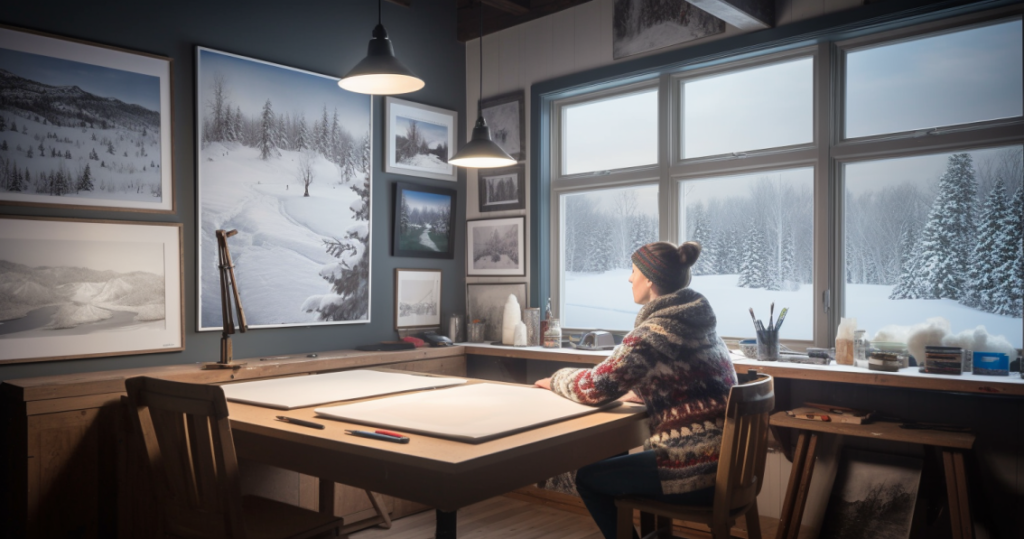When winter arrives, the world takes on a breathtaking transformation. As snow blankets the ground, artists across the centuries have captured this beauty, crafting scenes that transport you to serene and magical places. Winter paintings offer glimpses into a season rich with emotion, vividly portraying the colder months’ tranquil and sometimes harsh landscapes.
Winter Painting
From the detailed landscapes of Pieter Bruegel, the Elder, to the atmospheric charm of Impressionist scenes, winter-themed art highlights the stunning interplay of light, shadow, and color. These artworks capture the natural environment and the human stories, showcasing moments of play, work, and contemplation during the chilly months.
Exploring Winter Landscapes

Capturing the Essence of Snow
When you look at winter paintings, you’ll notice how artists skillfully capture snow’s unique qualities. They often use shades of white, blue, and gray to show the texture and sparkle of fresh snowfall. Paintings like Claude Monet’s “The Magpie” highlight how snow changes the look of the landscape, turning everyday scenes into something magical. Artists also consider how light interacts with snow, using shadows and reflections to create depth. This delicate interplay of light and shadow can convey calm and drama, making you feel the crispness and serenity of a snowy day.
Depicting Winter Wildlife
In winter landscapes, wildlife adds life and movement. Animals like deer, bears, and birds are common subjects, bringing a unique story to the scene. Artists might show a fox’s vibrant red against white snow to highlight survival and adaptation. You can find such scenes in many famous winter paintings. Artists remind you of nature’s resilience during harsh winters by including wildlife. These creatures often serve as a focal point in landscapes or blend seamlessly into the snowy backdrop, prompting a sense of wonder about the natural world and its rhythms throughout the chilly months.
Conveying Coldness and Warmth Through Color
Color plays a vital role in conveying the feel of winter. Artists often use cool colors like blues and purples to express cold, stark atmospheres. These colors make you feel the chill in the air. At the same time, warm colors like yellows and oranges can add contrast and warmth, hinting at sunset or light from a cozy cabin. This mixture of hues allows painters to express not just the coldness of winter but also the warmth of human or animal presence. The balance between these colors can evoke nostalgia and comfort, even in the heart of a frosty landscape.
Techniques and Materials for Winter Paintings

Choosing the Right Medium
Selecting the medium is crucial to achieve the desired effects in your winter painting. Acrylics are popular among beginners and offer versatility, with easy blending and a forgiving nature. They dry quickly and can add vibrant layers.
Conversely, watercolors provide a soft and translucent effect, perfect for subtle winter skies or snow. This medium requires more control but can produce beautiful, dreamy landscapes. For those looking into oil paints, they offer depth and rich colors but require longer drying times.
Experimenting with these mediums helps you discover what best suits your style. Pair your chosen medium with quality brushes to enhance your painting technique.
Texturing Techniques for Snow
Creating realistic snow requires an understanding of texture. Using tools like palette knives lets you make thick, textured snowdrifts. Scraping across the canvas with a palette knife adds dimension to your painting.
Dry brush techniques with stiff bristles can add the illusion of soft snow accumulating on surfaces. Using a stippling method, you can capture the individual snowflakes’ randomness and delicacy.
For a different texture, sprinkle salt on wet watercolor paint; this helps create a grainy effect reminiscent of falling snow. Mastering these techniques allows you to bring a snowy landscape to life with detail and authenticity.
Preserving the Winter Motif
Maintaining the winter theme involves embedding key elements in your painting. Soft, muted colors, such as shades of blue, white, and grey, represent the cold atmosphere well. Warm colors emphasize contrast, adding interest to dawn or dusk skies.
Incorporating elements like bare trees, icy streams, or frosty windows helps reinforce the winter setting. You can protect your finished work by applying a varnish. This preserves the colors and textures and shields it from dust and light damage.
These considerations ensure that your winter paintings remain fresh and vivid throughout the years.
Frequently Asked Questions – Winter Painting
What are some simple tips for beginners wanting to create a winter-themed painting?
Start with a limited color palette focusing on cool colors like blues and whites. Use reference images for inspiration and practice blending techniques to create smooth transitions between snow and sky. Experiment with different brush strokes to add texture to your snow-covered landscapes.
Can you suggest some creative winter painting ideas for a unique piece?
Create a scene of a frosty forest with snow-laden branches or a cozy cabin with glowing lights in the dusk. Try painting tranquil ice-covered lakes or the gentle fall of snowflakes. Adding small details like distant wildlife or footprints in the snow can make your painting stand out.
Which renowned artists are known for their winter landscape paintings?
Artists like Claude Monet, known for his “Snow at Argenteuil,” and Pieter Bruegel the Elder, famous for “The Hunters in the Snow,” have beautifully captured winter landscapes. Seeking inspiration from these artists can offer insights into composition and mood portrayal in your paintings.






